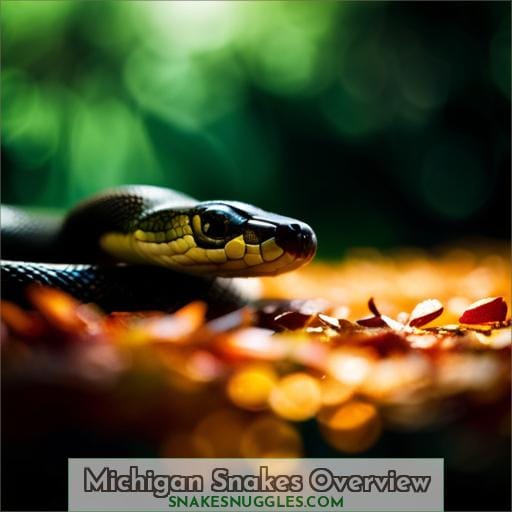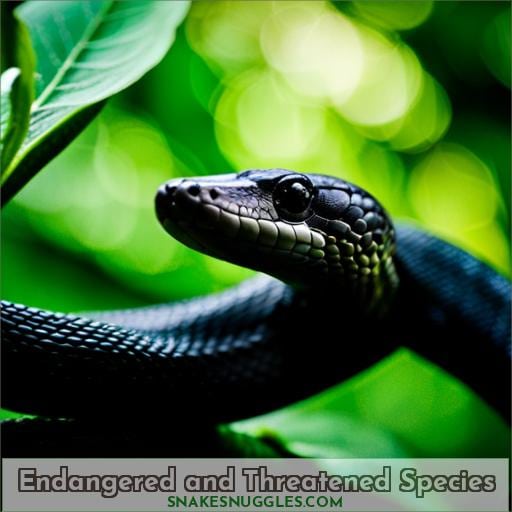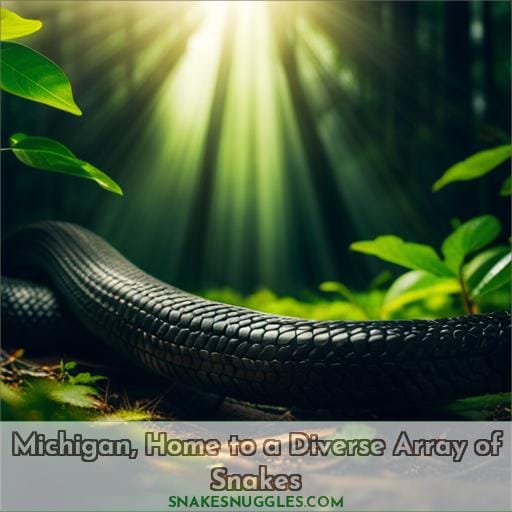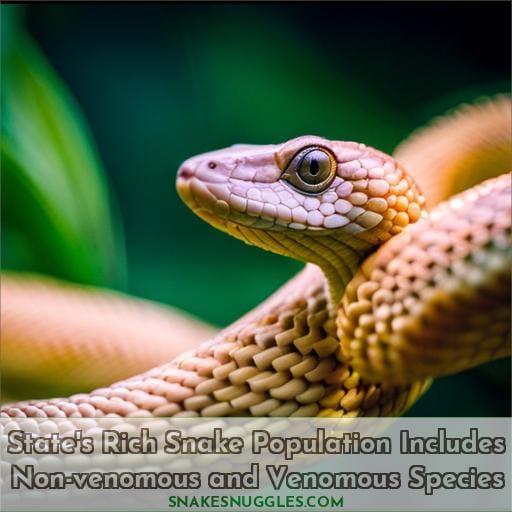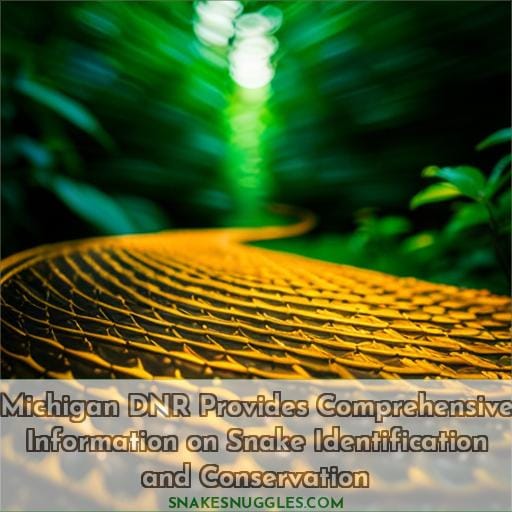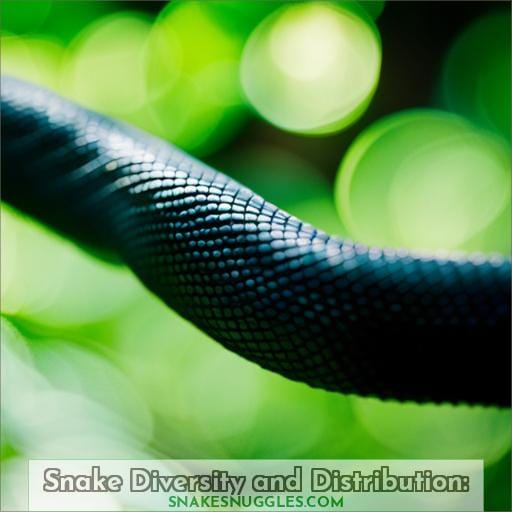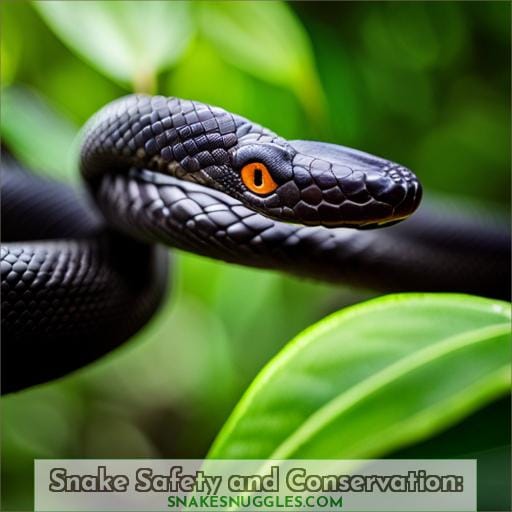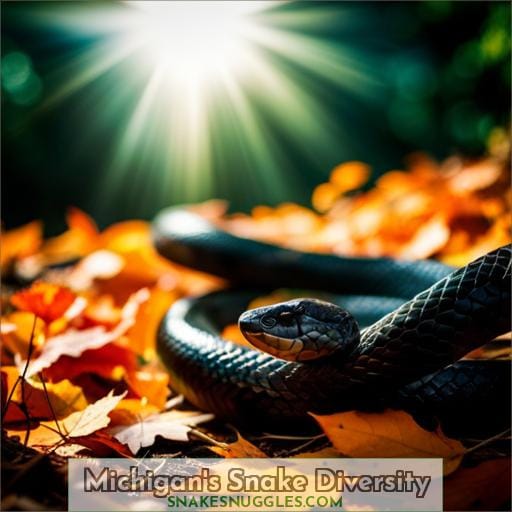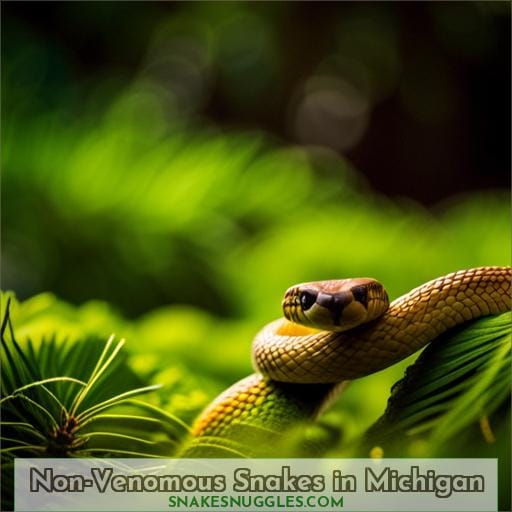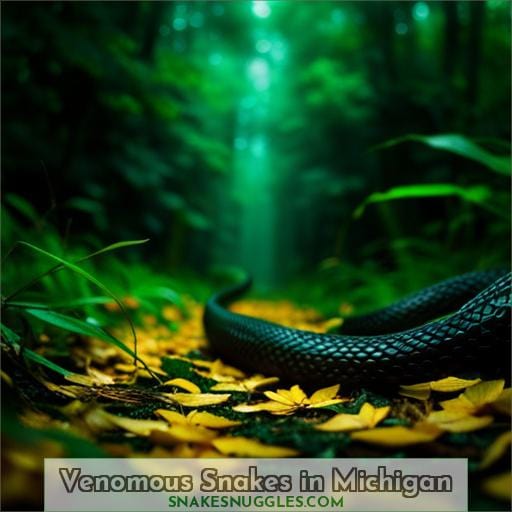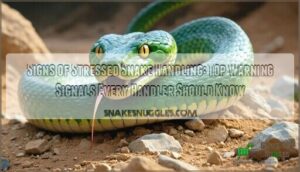This site is supported by our readers. We may earn a commission, at no cost to you, if you purchase through links.
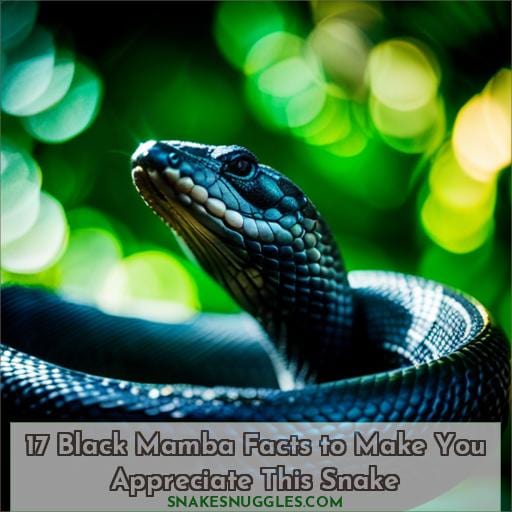 Unveiling the Enigma: Delve into the Fascinating World of Black Mambas
Unveiling the Enigma: Delve into the Fascinating World of Black Mambas
Prepare to embark on an enthralling journey into the captivating realm of black mambas, Africa’s most revered and formidable snakes. Unravel the intriguing tapestry of myths, characteristics, behaviors, venom potency, and treatment protocols surrounding these enigmatic creatures.
Discover the rich diversity of Michigan’s snake population, encompassing both venomous and non-venomous species, and gain insights into their habitats, identification tips, safety precautions, and conservation efforts.
Table Of Contents
- Key Takeaways
- Black Mamba Myths
- Black Mamba Characteristics
- Black Mamba Size and Behavior
- Black Mamba Venom
- Black Mamba Poisoning and Treatment
- Michigan Snakes Overview
- Non-Venomous Snakes
- Endangered and Threatened Species
- Michigan, Home to a Diverse Array of Snakes
- State’s Rich Snake Population Includes Non-venomous and Venomous Species
- Michigan DNR Provides Comprehensive Information on Snake Identification and Conservation
- Snake Diversity and Distribution:
- 17 Identified Snake Species:
- Eastern Hognose Snake: Interesting Behavior, Plays Dead When Threatened
- Fox Snake: Eastern Fox Snake is Threatened, Non-venomous
- Kirtland’s Snake: Endangered, Found in Southern Lower Peninsula
- Northern Ribbon Snake: Common in Wetland Areas, Great Swimmers
- Habitat Preferences:
- Woodlands: Some Snakes Thrive in Forested Regions
- Wetlands: Certain Species Are Adapted to Marshy Areas
- Meadows: Snakes Can Be Found in Grassy Fields
- Non-Venomous Snakes:
- Black Rat Snake: Michigan’s Largest Non-venomous Snake, Protected by State Law
- Blue Racer: Notable for Declining Population, Non-venomous, Tail Shaking When Threatened
- Brown Snake: Common, Non-venomous, Often Found Under Objects
- Butler’s Garter Snake: Common, Non-venomous, Primarily Feeds on Earthworms
- Eastern Garter Snake: Most Common Snake in Michigan, Non-venomous, Recognized for Red Tongues
- Venomous Snakes:
- Eastern Massasauga Rattlesnake: Special Concern, the Only Venomous Snake in Michigan, the Smallest U.S. Rattlesnake
- Identification Tips:
- Triangular Head: Venomous Snakes Often Have Triangular-shaped Heads
- Elliptical Pupils: Slit-like Pupils Are a Sign of Venomous Snakes
- Rattle: Eastern Massasauga Rattlesnakes Have a Rattle at the End of Their Tails
- Snake Safety and Conservation:
- Safety Precautions:
- Avoid Contact: Keep a Safe Distance From Snakes, Do Not Attempt to Handle or Disturb Them
- Respect Snake Habitats: Be Mindful of Snake Presence in Natural Areas
- Educate Yourself: Learn About Snake Identification and Behavior to Minimize Encounters
- Conservation Efforts:
- Habitat Preservation: Protecting Natural Habitats is Crucial for Snake Survival
- Public Education: Raising Awareness About the Importance of Snakes in Ecosystems
- Legal Protections: Some Snake Species in Michigan Are Protected by Law
- Seeking Professional Help:
- Snake Bite Treatment:
- Remain Calm: Stay Calm and Avoid Sudden Movements
- Seek Medical Attention: Call for Emergency Medical Assistance Immediately
- Immobilize the Area: Keep the Bitten Area Still and Below Heart Level
- Avoid Tourniquets: Do Not Apply a Tourniquet
- Snake Identification:
- Take a Photo: if Possible, Take a Photo of the Snake From a Safe Distance
- Consult Experts: Provide the Photo to Experts for Identification
- Michigan’s Snake Diversity
- Non-Venomous Snakes in Michigan
- Venomous Snakes in Michigan
- Snake Safety and Conservation
- Seeking Professional Help in Case of Snakebite
- Frequently Asked Questions (FAQs)
- How do black mambas communicate with each other?
- How intelligent are black mambas compared to other snake species?
- What is the average lifespan of a black mamba in captivity?
- Do black mambas have any natural predators other than mongooses and eagles?
- What is the role of black mambas in the African ecosystem?
- Conclusion
Key Takeaways
- Black mambas are not inherently aggressive and generally avoid contact with humans, challenging common myths and cultural perceptions.
- Despite their potent venom and formidable reputation, black mambas are shy and reclusive snakes that prefer to escape rather than confront humans.
- Black mambas possess unique behavioral adaptations, such as nesting with other snake species for warmth and protection.
- Michigan is home to diverse snake species, including nonvenomous snakes and the Eastern Massasauga Rattlesnake as the sole venomous snake in the state.
Black Mamba Myths
Let’s debunk some common myths about the black mamba, a snake often shrouded in mystery.
While it’s true that the black mamba is a venomous snake capable of delivering a deadly bite, many misconceptions and exaggerations surround this creature.
Contrary to popular belief, black mambas don’t chase cars or plan attacks on humans.
The myth of the black mamba balancing on its tail to strike is also false. In reality, they use their tails for climbing and stability.
Cultural perceptions and folklore often portray the black mamba as a symbol of death and danger.
However, behavioral studies reveal a more nuanced picture. Black mambas are shy and reclusive creatures that prefer to escape rather than confront.
Their reputation as fierce predators stems from their potent venom and lightning-fast strikes, which they use primarily for defense and securing prey.
Black Mamba Characteristics
Let’s delve into the fascinating characteristics of the black mamba, a creature that embodies power, agility, and a touch of mystery.
This snake’s behavior is as captivating as its appearance. Its diurnal nature means you’re more likely to encounter it during the day, basking in the sun’s warmth or slithering through the undergrowth in search of prey.
The black mamba’s habitat dynamics are as diverse as its diet. From termite mounds to hollow tree trunks, it adapts to a variety of environments, always seeking shelter and security.
Its venom, a potent cocktail of neurotoxins and cardiotoxins, is a testament to its evolutionary prowess. One bite can deliver enough venom to kill multiple humans, making it one of the most venomous snakes in the world.
Despite its fearsome reputation, the black mamba isn’t inherently aggressive. It prefers to avoid confrontation, using its speed and agility to escape potential threats. However, when cornered or threatened, it will毫不犹豫地 defend itself with lightning-fast strikes and a deadly venom.
Black Mamba Size and Behavior
Moving on to their size and behavior:
- You’ll find the black mamba is typically about 8 feet long, but they can grow up to 14 feet.
- This incredible length, coupled with their potent venom, makes them formidable predators.
- While they’re not inherently aggressive, they’ll defend themselves fiercely if threatened.
- Their lightning-fast strikes and ability to deliver multiple bites in rapid succession make them one of the most dangerous snakes in the world.
Yet, they’re also fascinating creatures, exhibiting unique behavioral adaptations:
- Like nesting with other snake species for warmth and protection.
- Their mating habits are intriguing too, with females laying clutches of eggs and then abandoning them, leaving the young to fend for themselves.
Understanding these aspects of the black mamba’s life unveils a complex and captivating creature.
Black Mamba Venom
Witness the black mamba’s toxic venom, a lethal liquid capable of ending your life with just two drops.
Its potency lies in the neurotoxins and cardiotoxins it harbors, wreaking havoc on your nervous system and heart.
Paralysis, respiratory failure, and cardiac arrest are just a few of the venomous effects that can manifest within an hour of a bite, making swift medical intervention crucial.
Antivenin exists, but its effectiveness depends on prompt administration. Even with antivenin, the mortality rate remains significant, highlighting the black mamba’s deadly reputation.
Medical advancements have improved the chances of survival, but the black mamba’s venom remains a formidable force, demanding respect and caution in any snake encounter.
Black Mamba Poisoning and Treatment
The black mamba’s venom is highly toxic, and a bite can be life-threatening if not treated promptly.
Its neurotoxins and cardiotoxins can cause a range of symptoms, including:
- Swelling
- Pain
- Loss of control
- Slurred speech
- Blurred vision
- Drowsiness
- Paralysis
- Confusion
Time is of the essence, as the bite can be fatal within an hour if symptoms appear rapidly.
Seek professional medical care immediately after a bite, as early treatment can greatly improve your chances of survival.
Antivenin is available and effective in neutralizing the venom, but it must be administered as soon as possible.
Regional differences in snake populations and venom potency necessitate the development of specific antivenins for each region.
Public awareness campaigns are crucial in educating people about the dangers of black mamba bites and the importance of seeking immediate medical attention.
Michigan Snakes Overview
You’ll be amazed by the diverse snake population in Michigan, boasting 17 identified species that inhabit various ecosystems, contributing to the state’s reptilian richness.
These snakes play crucial roles in maintaining ecological balance and controlling pest populations.
Michigan’s snake diversity includes non-venomous species like the Black Rat Snake, the largest non-venomous snake in the state, and the Eastern Garter Snake, the most common snake in Michigan, recognized for its distinctive red tongue.
The state is also home to the Eastern Massasauga Rattlesnake, the only venomous snake in Michigan, emphasizing the importance of snake conservation and habitat preservation.
Understanding Michigan’s snake diversity fosters coexistence with these fascinating creatures, appreciating their ecological contributions and dispelling misconceptions.
Non-Venomous Snakes
Let’s delve into the realm of non-venomous snakes, a diverse group you’ll encounter in Michigan’s natural habitats.
These fascinating creatures play a crucial role in maintaining ecological balance, controlling pest populations, and contributing to biodiversity.
The Black Rat Snake, Michigan’s largest non-venomous snake, is protected by state law. Its impressive size and arboreal nature make it a captivating sight in woodlands.
The Blue Racer, known for its decreasing population, is a non-venomous snake that exhibits a unique tail-shaking behavior when threatened.
The Brown Snake, a common sight in Michigan, prefers hiding under objects, while the Butler’s Garter Snake primarily feeds on earthworms, contributing to soil aeration and nutrient cycling.
The Eastern Garter Snake, the most prevalent snake in Michigan, is easily recognizable by its distinctive red tongue and intricate patterns.
Endangered and Threatened Species
Moving on to endangered and threatened species, you’ll discover the unique characteristics and conservation efforts surrounding Michigan’s most vulnerable snake species:
-
Copper-bellied Water Snake:
- This endangered snake, exclusive to the southern Lower Peninsula, faces habitat loss and fragmentation.
- Conservation efforts aim to protect its remaining wetlands.
-
Eastern Hognose Snake:
- Despite being common, this snake is declining due to human fear and persecution.
- Educational programs strive to dispel misconceptions and foster coexistence.
-
Eastern Massasauga Rattlesnake:
- Michigan’s only venomous snake and the smallest U.S. rattlesnake is a species of special concern.
- Habitat preservation and public awareness campaigns are underway to ensure its survival.
-
Kirtland’s Snake:
- Found in the southern Lower Peninsula, this endangered snake faces habitat loss and fragmentation.
- Conservation efforts focus on preserving its remaining natural areas.
-
Queen Snake:
- Although generally uncommon, this snake is threatened by habitat destruction and human encroachment.
- Conservation efforts aim to protect its wetland habitats.
Michigan, Home to a Diverse Array of Snakes
Michigan’s snake population is a diverse mix of non-venomous and venomous species.
Each species plays a crucial role in the state’s ecosystems.
These snakes inhabit various habitats, including woodlands, wetlands, and meadows, contributing to biodiversity and ecological balance.
Understanding their unique adaptations, species interactions, and predation patterns deepens our appreciation for their role in maintaining healthy ecosystems.
Conservation efforts aim to protect these fascinating creatures and ensure their continued existence alongside humans.
State’s Rich Snake Population Includes Non-venomous and Venomous Species
How about we delve into Michigan’s rich snake population, encompassing both non-venomous and venomous species?
Discover the behavioral traits, ecosystem roles, and population dynamics of these fascinating creatures.
Learn about their habitat preferences and how they interact with humans.
Michigan boasts a diverse array of snakes, each playing a unique role in the state’s ecosystems.
Non-venomous snakes, like the Black Rat Snake and the Eastern Garter Snake, are common sights, helping control rodent populations and maintaining ecological balance.
The state’s sole venomous snake, the Eastern Massasauga Rattlesnake, is a shy and secretive creature, rarely encountered by humans.
Understanding snake behavior and habitat preferences is crucial for peaceful coexistence.
Respect their presence in natural areas, maintain a safe distance, and avoid disturbing them.
By appreciating the role snakes play in our ecosystems and taking precautions for safety, we can foster a harmonious relationship with these captivating creatures.
Michigan DNR Provides Comprehensive Information on Snake Identification and Conservation
As you delve deeper into the world of Michigan’s snakes, you’ll discover a dedicated ally in the Michigan Department of Natural Resources (DNR). This organization has made it their mission to provide comprehensive information on snake identification and conservation, empowering you to navigate the state’s snake diversity with confidence.
Unveiling Michigan’s Snake Treasures:
The DNR website serves as a treasure trove of knowledge, offering detailed descriptions, habitat maps, and stunning photographs of Michigan’s snake species. Immerse yourself in the fascinating world of these often-misunderstood creatures, learning to appreciate their unique adaptations and ecological significance.
Unraveling the Mystery of Venomous Species:
If you’re intrigued by the captivating allure of venomous snakes, the DNR provides expert insights into the Eastern Massasauga Rattlesnake, Michigan’s sole venomous inhabitant. Discover the distinguishing characteristics that set this species apart, enabling you to admire its beauty from a safe distance.
Fostering Harmony Between Humans and Snakes:
The DNR champions the cause of snake conservation, recognizing the crucial role these creatures play in maintaining the delicate balance of Michigan’s ecosystems. Learn how to coexist peacefully with snakes, minimizing encounters and promoting their survival.
Snake Diversity and Distribution:
You’ll find 17 snake species in Michigan, including the endangered Copper-bellied Water Snake and the threatened Eastern Fox Snake.
These snakes inhabit diverse ecosystems, from woodlands and wetlands to meadows, playing crucial roles in maintaining ecological balance and controlling pest populations.
Some species, like the Northern Ribbon Snake, are known for their excellent swimming abilities.
17 Identified Snake Species:
Take a closer look at the diverse snake population in Michigan and discover the 17 identified species inhabiting various ecosystems.
From the non-venomous Black Rat Snake, Michigan’s largest, to the venomous Eastern Massasauga Rattlesnake, the smallest in the U.
Their behaviors, ecological impact, and habitats are as diverse as their species, highlighting the intricate interconnectedness of Michigan’s natural world.
Understanding and respecting these snakes promotes coexistence and ensures their continued presence in our shared environment.
| Name | Venomous | Habitat | Behavior |
|---|---|---|---|
| Black Rat Snake | No | Woodlands, meadows | Non-aggressive, excellent climbers |
| Blue Racer | No | Woodlands, meadows | Fast-moving, tail shaking when threatened |
| Brown Snake | No | Gardens, fields | Common, secretive, often found under objects |
| Butler’s Garter Snake | No | Wetlands, meadows | Common, feeds primarily on earthworms |
| Eastern Garter Snake | No | Gardens, fields, wetlands | Most common snake in Michigan, red tongue |
| Eastern Massasauga Rattlesnake | Yes | Wetlands, meadows | Only venomous snake in Michigan, triangular head |
Eastern Hognose Snake: Interesting Behavior, Plays Dead When Threatened
Meet the Eastern Hognose Snake, a fascinating creature that’ll fool you with its dramatic death-feigning act when threatened.
This remarkable snake has evolved an intricate defensive tactic: when confronted with a predator, it plays dead, lying motionless with its belly up and tongue hanging out.
Watch in awe as it contorts its body and even releases a foul odor to further convince its attacker of its demise.
These survival strategies showcase the incredible behavioral adaptations of the Eastern Hognose Snake, allowing it to thrive in its natural habitat.
Fox Snake: Eastern Fox Snake is Threatened, Non-venomous
- You’ll find the eastern fox snake, a threatened yet non-venomous species, in Michigan’s Upper Peninsula.
Its precarious status demands attention, urging you to champion its cause.
| Threatened Fox Snake | Conservation Challenges | Habitat Preservation | Human Impact | Snake Diversity |
|---|---|---|---|---|
| Population Decline | Habitat Loss | Protecting Natural Areas | Habitat Fragmentation | Michigan’s Rich Snake Fauna |
| Habitat Fragmentation | Climate Change | Educating the Public | Invasive Species | Eastern Fox Snake’s Significance |
| Climate Change | Pollution | Legal Protections | Agricultural Practices | Conservation Efforts |
Together, we can rally for the eastern fox snake’s survival, ensuring Michigan’s snake diversity thrives.
Kirtland’s Snake: Endangered, Found in Southern Lower Peninsula
The Kirtland’s snake, an endangered species found in the southern Lower Peninsula, faces conservation challenges due to habitat loss and human encroachment.
Their reproductive behavior, laying eggs in sandy soil, makes them vulnerable to disturbance.
Their unique habits, such as burrowing and secretive nature, further contribute to their endangered status.
Human impact, including habitat destruction and fragmentation, threatens their survival.
Habitat preservation and conservation efforts are crucial for the recovery of this species.
Northern Ribbon Snake: Common in Wetland Areas, Great Swimmers
Moving onto the Northern Ribbon Snake, you’ll find them commonly swimming in wetland areas, embodying the spirit of Wetland Wonders.
These snakes are Aquatic Allies, gracefully navigating the marshy marvels, performing their Water Ballet.
Discover their Ribbon Snake Adventures as they glide through the water, showcasing their mastery of their watery domain.
Habitat Preferences:
While Michigan’s diverse snake population inhabits various ecosystems, understanding their habitat preferences unveils their remarkable adaptations.
Woodlands provide shelter and nesting sites for certain species.
Wetlands nurture snakes adept at swimming and thriving in marshy environments.
Meadows offer ample hunting grounds for snakes that excel in open areas.
Comprehending these habitat preferences deepens our appreciation for their ecological roles, behavioral patterns, and the conservation strategies needed to safeguard these fascinating creatures.
Woodlands: Some Snakes Thrive in Forested Regions
Exploring Michigan’s woodlands, you’ll find snakes thriving amidst the trees and undergrowth.
These forest-dwelling serpents have developed remarkable adaptations to survive in this unique habitat.
With their forest adaptations, such as specialized camouflage strategies and arboreal behavior, these snakes navigate the dense vegetation with ease.
Some species even exhibit nocturnal adaptations to take advantage of nighttime hunting opportunities in these wooded environments.
Their presence has a significant ecological impact by controlling pest populations and contributing to overall biodiversity within Michigan’s woodlands.
Wetlands: Certain Species Are Adapted to Marshy Areas
Certain snake species are well-adapted to Michigan’s marshy wetlands, making them ideal habitats for these slithering creatures.
These wetlands provide ample food sources, such as frogs, fish, and other small creatures, allowing the snakes to thrive.
Marshy Adaptations:
Some snakes have evolved specialized adaptations for navigating and hunting in wetland environments.
Wetland Dwellers:
These snakes spend a significant portion of their lives in or near water, utilizing it for thermoregulation, hunting, and evading predators.
Swamp Survival:
Wetlands offer a rich ecosystem that caters to the unique needs of these wetland-adapted snakes.
Bog Biodiversity:
The diverse habitats within wetlands support a variety of snake species, contributing to the overall biodiversity of the region.
Meadows: Snakes Can Be Found in Grassy Fields
Venturing into meadows will reveal snakes thriving in grassy expanses.
They’re often shy and elusive, but their presence is undeniable.
Meet the meadow serpents, grassland crawlers, field reptiles, and prairie snakes.
These masters of camouflage blend seamlessly with their surroundings, making them a testament to nature’s diversity.
| Meadow Serpent | Grassland Crawler | Field Reptile | Prairie Snake | Meadow Biodiversity |
|---|---|---|---|---|
| Northern Water Snake | Eastern Fox Snake | Red-bellied Snake | Smooth Green Snake | Non-venomous |
| Butler’s Garter Snake | Eastern Garter Snake | Brown Snake | Ring-necked Snake | Venomous |
| Eastern Hognose Snake | Blue Racer | Kirtland’s Snake | Queen Snake | Endangered |
Non-Venomous Snakes:
The Black Rat Snake, Michigan’s largest non-venomous snake, is protected by state law.
The Blue Racer, notable for its declining population, is non-venomous and is known for shaking its tail when threatened.
The Brown Snake, common and non-venomous, is often found hiding under objects.
Black Rat Snake: Michigan’s Largest Non-venomous Snake, Protected by State Law
Michigan’s largest non-venomous snake, the Black Rat Snake, is protected by state law.
Its impressive size and striking black coloration make it a captivating sight.
These snakes play a crucial role in maintaining ecological balance by preying on rodents, contributing to a healthier ecosystem.
Conservation measures aim to protect their habitats and ensure their survival.
Their legal protection reflects the recognition of their ecological significance and the need for human coexistence.
Blue Racer: Notable for Declining Population, Non-venomous, Tail Shaking When Threatened
Next up, the Blue Racer, known for its dwindling numbers and non-venomous nature, stands out with its distinctive tail-shaking defense mechanism.
This species is a testament to the fragility of our ecosystems and the urgent need for conservation strategies.
Their tail-shaking behavior, a mesmerizing sight, is a reminder of the remarkable diversity of life on Earth.
Declining Populations Tail-Shaking Behavior Ecological Significance
Endangered Species
Conservation Strategies Non-Venomous Nature Human Impact on Habitats
Let’s work together to protect this enigmatic creature and ensure its survival for generations to come.
Brown Snake: Common, Non-venomous, Often Found Under Objects
Now let’s talk about the brown snake, a common non-venomous species often found hiding under objects.
They prefer moist, shady areas near water sources, often making their homes under rocks, logs, and debris.
While they’re not aggressive, they may bite if handled roughly.
Conservation efforts focus on preserving their habitats and reducing human impact.
Butler’s Garter Snake: Common, Non-venomous, Primarily Feeds on Earthworms
While other non-venomous snakes like Browns like to hide under objects, the Butler’s garter snake is typically found hunting primarily earthworms in the open.
Its diet consists almost exclusively of earthworms, making it an expert predator in its niche.
This snake prefers moist habitats like marshes, meadows, and damp woodlands, where it can easily find its favorite prey.
In Michigan, conservation efforts are underway to protect this unique snake’s habitat and ensure its survival.
Eastern Garter Snake: Most Common Snake in Michigan, Non-venomous, Recognized for Red Tongues
Butler’s Garter Snakes are common, but you’ll more likely encounter the Eastern Garter Snake, Michigan’s most prevalent snake, known for its distinctive red tongue.
Found throughout the state, these non-venomous snakes inhabit diverse habitats, from woodlands to wetlands.
Despite their abundance, Eastern Garter Snakes face challenges due to habitat loss and the misconception that they’re venomous.
Understanding and appreciating their role in maintaining ecosystem balance is crucial for their conservation.
Venomous Snakes:
You can easily identify venomous snakes by their triangular heads and elliptical pupils.
Recognizing these features will help you differentiate them from non-venomous snakes, especially when encountering the Eastern Massasauga Rattlesnake, which is the only venomous snake in Michigan.
It is known for its distinctive rattle at the end of its tail.
Eastern Massasauga Rattlesnake: Special Concern, the Only Venomous Snake in Michigan, the Smallest U.S. Rattlesnake
You’ll also find the Eastern Massasauga Rattlesnake, Michigan’s sole venomous snake and the country’s tiniest rattlesnake.
Its triangular head, elliptical pupils, and telltale rattle warn of its potent venom.
Though venomous, these shy creatures prefer to avoid confrontation, seeking refuge in wetlands and meadows.
Their survival hinges on habitat preservation and respectful human coexistence.
Identification Tips:
To help you identify a venomous snake, look for:
- A triangular-shaped head
- Elliptical pupils
These traits often signal the presence of venom.
The Eastern Massasauga Rattlesnake, Michigan’s sole venomous species, possesses these features.
Its triangular head and elliptical pupils, coupled with its rattle, serve as clear identifiers.
Familiarize yourself with these visual cues to navigate snake encounters safely.
Triangular Head: Venomous Snakes Often Have Triangular-shaped Heads
Often, you’ll notice venomous snakes have triangular-shaped heads.
This distinctive feature serves as a warning sign, urging caution.
The triangular shape accommodates their venom glands, allowing for swift and efficient venom injection.
Understanding this head shape is crucial for snake identification and avoiding potentially dangerous encounters.
Elliptical Pupils: Slit-like Pupils Are a Sign of Venomous Snakes
In addition, venomous snakes like the Eastern Massasauga Rattlesnake have elliptical pupils, or slit-like eyes.
This unique pupil shape enhances their vision in low-light conditions, allowing them to hunt effectively at dawn, dusk, and even at night.
Contrary to myths, their eyes don’t glow in the dark.
Understanding these pupil adaptations can help dispel misconceptions and foster a greater appreciation for the fascinating world of snakes in Michigan.
Rattle: Eastern Massasauga Rattlesnakes Have a Rattle at the End of Their Tails
Rattling their tails, Eastern Massasauga Rattlesnakes unleash a warning, a percussive declaration of their presence.
This rattle, a specialized tail segment, serves as a potent defense mechanism.
As they shake their tails, a series of interlocking rings collide, producing a distinctive sound that reverberates through the air.
This rattle behavior is an adaptation born from evolutionary pressures, a testament to their survival instincts.
It’s a warning, a plea for distance, a last-ditch effort to avoid confrontation.
Respect their boundaries, admire their adaptations, and appreciate their role in the delicate balance of nature.
Snake Safety and Conservation:
Keep your distance from snakes, don’t handle them, and tread carefully in snake habitats.
Aid conservation efforts by:
- Securing snake habitats
- Informing the public
- Upholding legal protections
Safety Precautions:
Keep your distance from snakes, avoiding sudden movements near them.
Respect their space and observe them from afar, appreciating their role in the ecosystem.
Preventing encounters with snakes starts with habitat conservation.
Support initiatives that protect their natural habitats and educate yourself about snake behavior to minimize the likelihood of an encounter.
In case of an emergency, respond swiftly by calling for medical assistance and providing a clear description of the snake if possible.
Public awareness campaigns can dispel myths and promote harmonious coexistence with snakes.
Avoid Contact: Keep a Safe Distance From Snakes, Do Not Attempt to Handle or Disturb Them
When encountering a snake, don’t approach it; maintain a safe distance.
This simple act can save your life.
Snakes are wild animals with unpredictable behaviors.
Their habitats are dynamic and complex, and disturbing them can lead to defensive strikes.
By respecting their space, you ensure your safety and minimize the risk of conflict.
Respect Snake Habitats: Be Mindful of Snake Presence in Natural Areas
- Be mindful of snake presence when you’re in natural areas to avoid disturbing them.
Respect their habitats and avoid altering their natural environment.
Human encroachment and habitat destruction disrupt ecological balance, harming snake populations.
Learn about snake habitats and behaviors to minimize encounters.
The Michigan DNR provides resources to educate the public about snake conservation and coexistence.
Educate Yourself: Learn About Snake Identification and Behavior to Minimize Encounters
Brush up on snake identification and behavior cues to minimize potential encounters and promote safe coexistence.
Learn to recognize common snake species in your area, their habitats, and their typical behaviors.
By understanding their patterns, you can adjust your activities to minimize the chances of encountering them unexpectedly.
This knowledge empowers you to navigate natural spaces confidently, fostering a harmonious relationship with these fascinating creatures.
Conservation Efforts:
You can help protect snakes by preserving their natural habitats and educating others about their importance in the ecosystem.
To ensure the conservation of snake species, several initiatives are essential:
- Wildlife corridors: Establishing protected pathways between fragmented habitats allows snakes to move freely and maintain genetic diversity.
- Community engagement: Educating local communities about the benefits of snakes promotes coexistence and reduces human-wildlife conflict.
- Habitat restoration: Restoring degraded snake habitats through reforestation or wetland restoration efforts helps provide suitable environments for these creatures.
- Biodiversity monitoring: Regular monitoring of snake populations provides valuable data on population trends, distribution patterns, and overall health status, aiding in targeted conservation strategies.
Habitat Preservation: Protecting Natural Habitats is Crucial for Snake Survival
Often, conserving natural habitats is essential for the survival of many snake species, including the black mamba.
Protecting ecosystems ensures a harmonious balance between humans and wildlife.
Conservation strategies focus on preserving biodiversity, establishing wildlife sanctuaries, and implementing habitat restoration projects.
These efforts provide snakes with the necessary resources and shelter to thrive, ultimately ensuring their survival and the preservation of delicate ecosystems.
| Conservation Strategy | Goal | Impact on Black Mamba |
|---|---|---|
| Ecosystem Preservation | Protecting natural habitats | Ensures a harmonious balance between humans and wildlife |
| Conservation Strategies | Preserving biodiversity | Supports a diverse range of snake species, including the black mamba |
| Wildlife Sanctuaries | Establishing protected areas | Provides safe havens for black mambas and other wildlife |
| Habitat Restoration | Restoring degraded habitats | Creates suitable living conditions for black mambas and their prey |
Public Education: Raising Awareness About the Importance of Snakes in Ecosystems
Raising awareness about the importance of snakes in ecosystems is crucial, as they play a vital role in controlling rodent populations and maintaining a balanced environment.
Conservation Initiatives:
Support organizations dedicated to snake conservation, such as wildlife rehabilitation centers, to ensure the survival of these fascinating creatures.
Ecosystem Benefits:
Educate the public about the ecological significance of snakes, emphasizing their role in maintaining biodiversity and controlling pests.
Community Engagement:
Organize educational events, seminars, and workshops to foster a greater understanding and appreciation for snakes among local communities.
Legal Protections: Some Snake Species in Michigan Are Protected by Law
Because some snake species in Michigan are protected by law, you should familiarize yourself with the legal regulations surrounding their handling and conservation.
Wildlife regulations ensure the protection of these snakes and their habitats.
By understanding the legal implications, you can contribute to conservation efforts and help preserve these protected species’ populations.
It’s essential to respect wildlife laws and advocate for habitat preservation to maintain a healthy ecosystem for both snakes and other wildlife in Michigan.
Seeking Professional Help:
If you’re bitten by a snake:
- Remain calm.
- Call for emergency medical assistance immediately.
- Keep the bitten area still and below heart level.
Avoid applying a tourniquet.
Snake Bite Treatment:
In the event of a black mamba bite, seeking immediate medical assistance is paramount for your survival. Your life is in your hands; act quickly.
Emergency Response:
- Dial emergency services without delay. Every second counts.
First Aid:
- Immobilize the bitten area and keep it below your heart.
- Avoid using a tourniquet.
Venom Antidotes:
- Seek professional medical care for prompt administration of venom antidotes.
Wildlife Rehab:
- If possible, take a photo of the snake for identification purposes, but do so from a safe distance.
Remain Calm: Stay Calm and Avoid Sudden Movements
When bitten by a snake, staying calm and avoiding sudden movements can help minimize the spread of venom.
Panicking and thrashing can accelerate the venom’s circulation, increasing its potency.
Instead, adapt calmly, understanding that remaining composed can significantly influence the severity of the situation.
React thoughtfully, controlling your reactions and movements to prevent further harm.
Seek Medical Attention: Call for Emergency Medical Assistance Immediately
Don’t hesitate to call for emergency medical assistance right away if you’ve been bitten by a black mamba.
-
Dial 911 Immediately:
- Don’t delay; call emergency services as soon as possible.
- Provide the dispatcher with your location and a description of the snake that bit you.
-
Seek Urgent Care:
- If you can’t reach 911, rush to the nearest medical facility.
- Time is of the essence, so don’t waste a moment.
-
Convey Symptoms Accurately:
- Inform the medical personnel about the bite, including the time, location, and any symptoms you’re experiencing.
-
Cooperate with Treatment:
- Trust the medical professionals and follow their instructions.
- They’ll administer antivenom and provide the necessary care to save your life.
Immobilize the Area: Keep the Bitten Area Still and Below Heart Level
Keep the affected area still and below your heart to slow the spread of venom.
Immobilization minimizes the venom’s absorption into your bloodstream, potentially mitigating the severity of the bite.
This crucial first aid measure can buy you valuable time as you seek emergency medical attention.
Avoid Tourniquets: Do Not Apply a Tourniquet
Applying a tourniquet is strongly discouraged as it can exacerbate tissue damage.
Instead, seeking professional help should be your priority in the event of a black mamba bite.
Tourniquets restrict blood flow and may lead to further complications.
Professional medical care is critical for administering antivenom and managing symptoms effectively.
It’s important to remember that black mambas are venomous snakes with highly toxic venom, so immediate medical attention is crucial for your safety and well-being.
Snake Identification:
Taking a picture of the snake from a safe distance will help experts identify it.
Should you ever encounter a snake in Michigan, whether venomous or non-venomous, don’t attempt to handle it.
-
Observe from Afar:
- Maintain a safe distance and observe the snake’s behavior and physical characteristics.
-
Capture an Image:
- If possible, take a clear photograph of the snake from a safe distance. This will aid in identification.
-
Note the Location:
- Record the exact location of the encounter, including the county, township, and any landmarks.
-
Contact Experts:
- Reach out to local wildlife authorities, herpetologists, or conservation organizations for assistance in identifying the snake species.
-
Preserve the Environment:
- Avoid disturbing the snake’s habitat or leaving any trash behind.
Take a Photo: if Possible, Take a Photo of the Snake From a Safe Distance
If you can do so safely, take a photo of the snake from a safe distance.
This will aid experts in identifying the species and provide valuable data for conservation efforts.
Ethical photography involves respecting the snake’s habitat and avoiding disturbing its natural behavior.
Maintain a respectful distance and use a zoom lens to capture detailed images.
Your observation and photography can contribute to a better understanding and appreciation of the snake’s role in the ecosystem.
Consult Experts: Provide the Photo to Experts for Identification
When you encounter a snake, why not snap a picture and send it to an expert for identification?
Unraveling the mysteries of the snake world requires a keen eye and expertise.
By consulting professionals, you contribute to a greater understanding of species diversity, habitat preferences, and conservation efforts.
Embark on a journey of discovery, empowering yourself with knowledge and appreciation for these fascinating creatures.
Michigan’s Snake Diversity
Now, let’s turn our attention to Michigan, a state brimming with diverse snake species.
This Midwestern gem is home to 17 snake species, each playing a crucial role in maintaining ecological balance.
Discover the fascinating world of Michigan’s snakes, from the non-venomous Black Rat Snake, the state’s largest, to the venomous Eastern Massasauga Rattlesnake, the smallest in the U.
As you venture into Michigan’s natural habitats, you’ll encounter snakes thriving in woodlands, wetlands, and meadows.
Their presence is a testament to the state’s commitment to biodiversity preservation.
These often-misunderstood creatures are vital players in the ecosystem, controlling pest populations and ensuring a healthy balance.
Understanding snake conservation is paramount.
Human encroachment and misconceptions have negatively impacted snake populations.
By dispelling myths and fostering a sense of appreciation for these remarkable creatures, we can work towards their protection.
Non-Venomous Snakes in Michigan
Michigan’s diverse population of 17 snake species includes non-venomous snakes that play a crucial role in maintaining ecological balance by controlling pest populations.
The Black Rat Snake, Michigan’s largest non-venomous snake, is protected by state law.
The Blue Racer, known for its decreasing population, exhibits a unique defense mechanism by shaking its tail when threatened.
The Brown Snake, a common sight in Michigan, prefers hiding under objects, while the Butler’s Garter Snake, also common, primarily feeds on earthworms.
The most prevalent snake in Michigan, the Eastern Garter Snake, is easily recognized by its distinctive red tongues.
These non-venomous snakes contribute to a healthier ecosystem by keeping rodent populations in check, highlighting the importance of habitat preservation and human coexistence.
Wildlife education initiatives can help foster a greater appreciation for these fascinating creatures and promote harmonious relationships between humans and snakes.
Venomous Snakes in Michigan
In Michigan, you’ll encounter one venomous snake: the Eastern Massasauga Rattlesnake.
Known for its triangular head and elliptical pupils, this shy and reclusive creature plays a crucial role in the ecosystem by controlling rodent populations and maintaining ecological balance.
Sadly, public perceptions and misconceptions often lead to its persecution, disrupting the delicate balance of nature.
While the Eastern Massasauga Rattlesnake’s venom can be potent, its bites are rare.
By understanding its behavior and respecting its role in the ecosystem, we can coexist harmoniously with this fascinating creature.
Wildlife conservation efforts, including habitat preservation and public education, are essential to ensure the survival of this iconic snake and maintain the ecological integrity of Michigan’s diverse ecosystems.
Snake Safety and Conservation
Snake safety starts with respecting their presence in natural areas.
Give them space and avoid disturbing their habitats.
Educate yourself about local snake species, their behaviors, and habitats.
This knowledge empowers you to coexist safely with these fascinating creatures.
Advocate for snake conservation.
Support organizations dedicated to habitat protection, wildlife education, and reptile preservation.
Your voice can make a difference in securing a future where snakes and humans thrive together.
Simple actions like avoiding littering and reducing our carbon footprint contribute to a healthier environment for snakes.
By conserving their habitats, we create a world where these magnificent creatures can continue to play their vital ecological roles.
Seeking Professional Help in Case of Snakebite
If bitten, don’t panic.
Stay calm, avoid sudden movements, and call for immediate medical assistance. Every second counts.
Swift Action:
Rapid response is crucial. Venom can spread quickly, so getting to a hospital as soon as possible is essential.
First Aid Measures:
While waiting for medical help, keep the bitten area still and below your heart level.
Don’t apply a tourniquet, as it can worsen the situation.
Accurate Identification:
If possible, take a photo of the snake from a safe distance.
This will help medical personnel identify the snake and administer the appropriate antivenom.
Antivenom Availability:
Antivenom is effective in neutralizing the venom, but it must be administered promptly.
Be prepared for potential allergic reactions to the antivenom.
Frequently Asked Questions (FAQs)
How do black mambas communicate with each other?
Black mambas communicate primarily through visual cues and body language.
They use their raised heads, flattened hoods, and hissing sounds to signal aggression or defend territory.
These signals play a crucial role in establishing dominance and avoiding confrontations with other snakes.
How intelligent are black mambas compared to other snake species?
Their nimble movements and lightning-fast strikes demonstrate an aptitude for survival, making them formidable predators in their African habitat.
Their intelligence is reflected in their ability to adapt to diverse environments and their cunning hunting strategies.
What is the average lifespan of a black mamba in captivity?
The average lifespan of a black mamba in captivity is around 10 to 12 years.
However, some individuals have been known to live up to 20 years, showcasing their resilience and adaptability in controlled environments.
Do black mambas have any natural predators other than mongooses and eagles?
Yes, crocodiles have been known to prey on black mambas, though this is a rare occurrence.
Additionally, larger snakes may consume smaller black mambas.
What is the role of black mambas in the African ecosystem?
In the vast expanse of the African ecosystem, you’ll find the black mamba, a lethal predator that commands respect.
Its role is as crucial as it’s deadly, maintaining a delicate equilibrium by keeping rodent populations in check.
Thus preventing the spread of disease and ensuring the health of the entire ecosystem.
Conclusion
Despite their fearsome reputation, black mambas are intricate creatures with fascinating behaviors and ecological significance.
Their venom’s potency serves as a stark reminder of nature’s duality, capable of both destruction and healing.
As you venture into Michigan’s snake-rich habitats, remember that these enigmatic reptiles play a vital role in maintaining ecological balance.
Respect their presence, learn about their behaviors, and appreciate their beauty from a safe distance.






